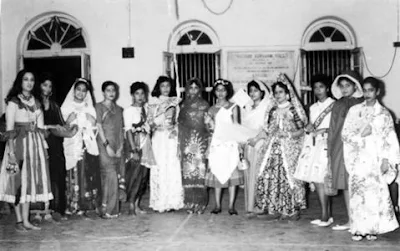According to a 1957 newspaper article in America’s Washington Post, Karachi’s beaches were some of the ‘cleanest beaches in Asia’. Tiny working-class settlements (gohts) near these beaches began to expand.
Military police personnel in Karachi checking licenses of car-owners in 1958.
Pakistan military chief, Field Marshal Ayub Khan, had come to power through a military coup. He ordered a crackdown against corruption and crime in Karachi which had grown ever since the city’s economy had begun to struggle from the mid-1950s onward.
Pakistan’s first leading female industrialist, Razia Ghulam Ali, giving instructions to an employee at her factory in Karachi. The Ayub regime had made Karachi the focus of its rapid industrialisation project.
A rare 1965 photograph of the last remnants of Karachi’s Jew community.
The community had grown in size in the early 1900s, but began to shrink from the 1950s onward. By the 1960s, only a handful of Jews remained in Karachi. They completely vanished after late 1960s (moving abroad).
Members of Karachi’s Jew community spoke fluent Hebrew, English, Urdu and even some Arabic
1967: An air-hostess of Pakistan International Airlines (PIA) pours Champagne for a business-class passenger at Karachi Airport.
In the 1960s, PIA rapidly emerged as one of the top airlines in the world and the Karachi Airport became ‘the gateway to Asia’.
Pro-Ayub graffiti on a wall in Karachi during the 1965 Presidential election.
Ayub Khan (Muslim League-Convention) defeated Fatima Jinnah (of Combined Opposition Parties — an alliance of anti-Ayub left and right outfits) and was re-elected as President. However, Karachi was the only city which voted against Ayub.
Marriot, 1977: This is a 1977 photograph showing Islamabad’s Marriot Hotel (then called Holiday Inn) being constructed. Almost three decades later this famous hotel was blown up by suicide bombers and/or psychotics who were in a hurry to reach the rooms their handlers had booked for them in paradise.
A woman suffering from the fatal bubonic plague awaits treatment in 1890, Karachi
Safer days, shorter walls: This is a 1974 picture of Karachi’s iconic Pearl Continental Hotel (then called theIntercontinental). Notice the short walls of the hotel, hardly 3 and a half feet tall!
Now compare them with the tall, thick walls and the chaotic barbed wire that surround the same hotel today and what with all the concrete barriers and dozens of armed security personnel that one has to go through.An 1839 sketch of Karachi drawn by a British traveller on the eve of Britain’s conquest of the city.
Chief Justice of Pakistan (Chief Justice) Hamood-ur-Rehman with Prime minister
Talking heads: A terrific 1975 photograph of a scholarly talk show on PTV. Intellectual talk shows were rather popular on TV in Pakistan in the 1970s. This one shows renowned playwrights, Ashfaq Ahmed and Bano Qudsia (centre right), talking about ‘socialist plays’ with the host.
Taliban, who? No, this is not an image from a bygone hippie flick. It is a picture of real hippies enjoying a few puffs of hashish on the roof of a cheap hotel in Peshawar in 1972. Yes, Peshawar.
At the art of it all: This 1975 photograph shows a group of some of Pakistan’s famous painters and sculptors with a visiting British artist at the Karachi Arts Council. Check out the flares, the sideburns and all. And they’re smoking inside the building. Awesome.
The King wuz here:Rare poster of Indian Ghazal king (and queen) Jagit & Chitra’s tour of Lahore in 1979. They held a series of successful concerts, with the most colourful one taking place in the city’s historical Shalimar Gardens.
Hippie invasion: Cover of the soundtrack album (LP) of 1974 box-office hit, Miss Hippie. The film depicted the ‘effect hippie lifestyle and fashion were having on Pakistani youth.’ (sic)
How many of you know or remember that the entire crew of NASA’s Apollo 17 flight to the moon visited Pakistan? In July 1973, astronauts of the United State’s last mission to the moon arrived in Karachi.
Their visit was widely covered by the press and Pakistan Television (PTV). The astronauts were also honoured by a ‘welcome motorcade procession’ that travelled from Clifton Road till Tower area.
The photograph shows the motorcade reaching the Saddar area that was decorated with Pakistani, American and PPP flags and colourful banners.
Some of the astronauts travelled in an open truck (see picture). The truck also carries a banner that reads (in Urdu): ‘Welcome to the Apollo 17 astronauts.’
Legend Pakistani Drama Actors
[L to R] Jamal Shah, Talat Hussain, Faryal Gohar and Shakeel.
Directed by: Alastair Reid
One the sets of the English Film - Traffik [1989]
Say, Vat? Nothing extraordinary about this old 1975 Urdu film poster of a movie released at a time when the country’s film industry was booming. However, check out the bottle of whiskey, Vat-69. This brand of whiskey, appeared in hundreds of Pakistani films between 1950s and late 1970s.Damned greatness: A 1976 photo of Pakistan’s Nobel Prize winning scientist, Dr. Abdus Salam (right), with a colleague at a summer college held at Pakistan’s scenic Nathiyagali resort.
Statue of the British Queen being unveiled at Karachi’s Frere Hall Park during a ceremony.
Che in Karachi : Yes, that’s the great Marxist revolutionary and legend, Che Ernesto Guevara, standing along side Pakistan’s first military dictator, Ayub Khan. Guevara stayed for a short while in Karachi during his whirlwind tour of Arab and third world countries (in 1959). He again visited Karachi in 1965 and that is when the above photograph was believed to have been taken (inside the VIP lounge of the Karachi Airport).
US President Richard Nixon at ancient site in Taxila (Pakistan) on 2nd August 1969.
Young Cadet Ashfaq Pervaiz Kayani (COAS)


























No comments:
Post a Comment